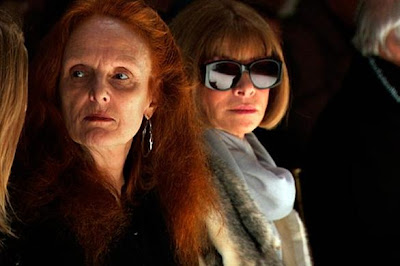The lady with the ax: Anna Wintour in The September Issue

One can sense that Vogue editor-in-chief Anne Wintour did not relish or especially welcome R. J. Cutler's documentary cameras into her world. She probably did it as a practical business decision just as she foresaw how celebrities such as Sienna Miller (and currently Tina Fey) would take over the covers of Vogue. It proved a savvy means to temporarily offset the inevitable decline in the magazine's circulation (as far as I know, the September Issue of 2007, with 644 pages, was its largest issue, and it has shrunk since then).
"It's always going to be Anna's point of view. Vogue is Anna's magazine. That's who signs it off. We know that." --an employee at Vogue


Of course, with her offices above Times Square, Wintour's rarefied fashion world was the chief inspiration for The Devil Wears Prada and its many rom com imitators such as Confessions of a Shopaholic, so I enjoyed comparing the documentary with the Prada variation. Next to Meryl Streep's quiet steely voice, Anna sounds clipped, almost passive and unassuming with her slight British accent. Anna doesn't mind looking almost girlish with her frosted brown bobbed hair, high heels, and colorful print dresses. In comparison to Miranda Priestly, Anna comes across as very introverted, her gestures restrained. Whereas the creative director Grace Coddington enjoys confiding with Butler's crew as a way to gain leverage with Anna, Wintour rules by saying no, by never finding anything that her underlings show her to be quite good enough for inclusion in Vogue. Anna dislikes black and she's great with her withering putdowns like "Where's the glamour?" and, while looking at a model in a photo, "She looks pregnant." In order to maintain high standards for Vogue, she carries around the ax that forces photographers, art directors, and assistant editors to try harder.

I especially liked one shot of Anna getting into her limousine on the way to work. As the New York landscape slides by, she just sits there, suffering the camera's gaze on her necklace, her dress, and the cell phone in her lap. It's this tension between her autocratic celebrity side (with distant photographers yelling Anna! Anna! as she walks by a barricade in Paris) and her occasional more human moments that makes the film work. Cue the electronica music and the montage of models walking in their peculiar hip-slung way (as if they lounge back on their pelvis as they move); Anna watches and keeps her own counsel.
"We have had a famine of beauty. My eyes are starving for beauty!" --Andre Leon Talley, Vogue's editor-at-large

As someone not living in New York City, I am often surrounded with much indifference to fashion and personal appearance (although I have noticed that Americans tend to dress more colorfully than Europeans), so I enjoy a documentary where most everyone wants to make an aesthetic statement every time they dress (Andre even brings designer accessories to tennis practice). Yet, there are times when the Vogue gang get a bit fed up with so much beauty. Anna's daughter Bee Shaffer, for instance, refuses to pursue a career in fashion editing. She would prefer to study law. As she says, "Fashion is a weird industry for me. It takes itself too seriously. People believe that fashion is life, but for me there are other things." At one point, as if in revenge, Vogue turns its cameras on Cutler's cameraman, asking him to jump up in the air for a color blocking reshoot (Vogue, I've noticed, likes to have its models hop to enliven a shot). When the resulting photograph emphasized his paunch, Anna wanted the image photoshopped to make him thinner, but Grace Coddington said no. She wanted his pudgy gut in the September issue, saying with some resignation "It's enough that the models are perfect."
Ultimately, I liked The September Issue because Anna Wintour does not have to break down and cry to humanize herself as Miranda Priestly does late in The Devil Wears Prada. Wintour does not need to get very dramatic at all. As a subject of a documentary, she gives very little away. She lets Vogue speak for itself.


Comments
I really enjoyed this movie and the pretzel it left me in afterward:
Clearly Wintour is an intelligent woman who understands how to play the game. And yet when we watch her she never seems to play to the camera. That is, she never breaks character.
So while I have no illusions that we saw the real, real Wintour -- the woman behind the mask -- I do feel like we saw as deeply into her as she allows almost anyone to see, and that's no small thing. Many documentary subjects allow the cameras inside, but, if they're savvy enough to understand the game, the "inside" that they reveal is a fake one, sometimes less real than their faux exterior, because it's just being conjured up for the cameras.
So was I conned by Wintour? Those moments when she seemed to let her guard down ever so slightly ... where those reflections of the real her, or were those carefully considered maniuplations of her image (which would be part of the real Anna, too, obviously)? I don't know. But she's sure interesting to watch, even though I don't share her interests in the slightest.
On the other hand, the recent Vogue emphasizes the pressure she must be feeling from fashion bloggers (damn it! They work for free!). They get their own spread late in the issue. I also like this quote from the letters: [After complimenting a previous issue,] "Stories of this depth can't be read on any blog."